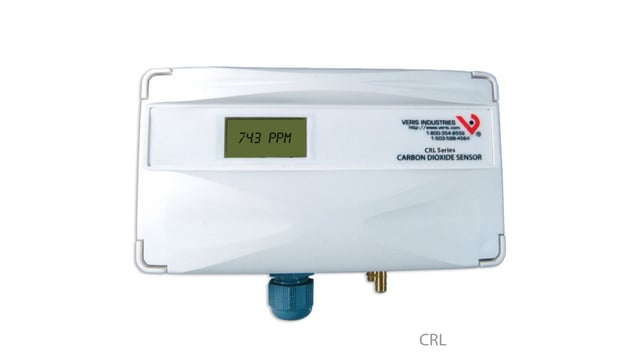CO2 Sensors for HVAC Systems: A Guide

Optimized ventilation and improved indoor air quality are key concepts in modern buildings. Over-ventilating increases energy costs, but under-ventilated spaces have other costs…for the safety, health, and comfort of all occupants.
One of the best strategies for managing and improving both energy efficiency and indoor air quality is with CO2 sensor testing. Fan and HVAC system performance can’t be evaluated in a vacuum, based on usage or energy expenditures alone — you need to look at the results.
Veris’ long-lasting and reliable products, like Veris’ CW2 Series IAQ Sensors, help facility managers carefully monitor CO2 levels. Our products reveal whether your system is optimized for current occupancy levels, overcompensating, or needs to work harder (or receive an upgrade).
How to Correctly Install and use Veris’ CO2 Sensors
Our CW2 Protocol Series of CO2 wall mount sensors are easy to install and operate. You’ll want to install these wall-mounted sensors away from windows vents, and other sources of draft, as this may cause inaccurate readings. Simply mount the backplate to the wall 4.5 feet above the floor with provided screws and connect the AWG cables to the screw terminals through the backplate. Next, configure the device. You can see more details on proper installation in this guide.
A duct CO2 sensor, by contrast, is designed to be mounted and measure CO2 levels within the ducts of your HVAC system. These sensors detect fluctuations in CO2 levels and signal ventilation systems to provide an inlet of fresh air optimal for the space.
Remote CO2 sensors provide flexibility for unique applications and can be mounted to conduct outside air measurements. Using a direct measure of outside air or a sample from other remote areas, the sensor can remotely control HVAC to deliver fresh air when a comparison shows that indoor CO2 levels are elevated from occupancy.
How Much CO2 is Too Much?
According to ASHRAE, CO2 concentrations in outdoor air typically range from 300 to 500 ppm.
Levels are typically somewhat higher in indoor spaces. Only at a very high concentration (greater than 5000 ppm) does CO2 pose a significant health risk, but concentrations rarely reach these levels inside most buildings.
Nonetheless, indoor CO2 concentrations of 700 to 1200 ppm indicate proper ventilation and indoor air quality that would satisfy the majority of visitors and occupants.
Proper ventilation has taken on added importance in light of the COVID-19 pandemic. Many school districts, for instance, are now making valuable investments in permanent upgrades to IAQ monitoring technologies and HVAC systems. Recent education stimulus funds are eligible for use on filtration, ventilation, purification, and other air cleaning systems.
Top 3 Benefits of CO2 Sensors
- Helps to Monitor Hazardous CO2 Levels: CO2 can become hazardous in 1 of 2 ways: by displacing oxygen in the bloodstream or when acting as a toxin. When being around high levels of CO2, common symptoms can include headaches, fatigue, and lack of attention.
- Helps to Increase Productivity and Human Cognition: In schools or offices, where CO2 levels are elevated due to the number of people, high CO2 concentration was found to increase headaches, decrease information utilization, decrease performance in general and increase rates of absenteeism.
- Monitoring CO2 for Energy Efficiency: Veris’ CO2 sensors can help you to navigate the balance between energy efficiency and compliance with ASHRAE standards for environmental control and indoor air quality. Explore our LEED certification table to learn more about how Veris can assist in your building’s pursuit of LEED certification.
Achieve Better Air Quality and Ventilation with Veris’ CO2 Sensors
Our high-quality CO2 wall mount sensors, duct CO2 sensors, and remote CO2 sensors are designed for ease of installation, affordability, and industry-leading precision. Deploy our CO2 sensor testing solutions in your building to improve indoor air quality, increase occupant comfort, and protect their health — while also reducing energy consumption through efficient operations.
Try our Build-A-Sensor tool today to find the perfect CO2 sensor to meet your needs. If you’re interested in using Veris CO2 Sensors in LEED Certification, download the guide or schedule a virtual meeting with a knowledgeable Veris rep at your earliest convenience!





